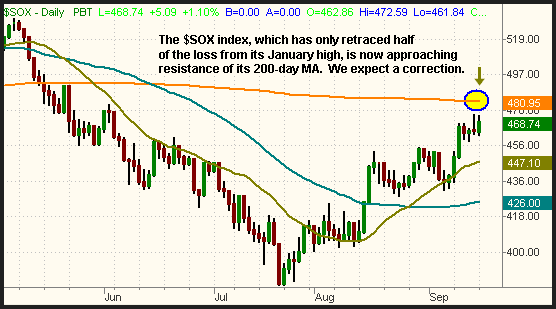The broad market drifted higher throughout the morning session, but a modest selloff in the early afternoon caused the major indices to finish near unchanged levels and in the middle of their intraday ranges. The S&P 500 gained 0.1%, the Dow Jones Industrial Average lost 0.1%, and the Nasdaq Composite was unchanged. The S&P Midcap 400 Index was also unchanged, while the small-cap Russell 2000 edged 0.1% lower. Each of our open positions that were showing an unrealized gain moved deeper into positive territory, while our IWM short position erased a bit more of its market to market loss.
Total volume in the NYSE declined by 31% yesterday, while volume in the Nasdaq was 22% lighter than the previous day's level. Because the previous session was a "quadruple witching" options expiration day, turnover was expected to be lower. Still, volume remained above average levels and well above the lethargic activity of last month. Market internals were positive, but only by a small margin. In the Nasdaq, advancing volume exceeded declining volume by a margin of just over 3 to 2. The NYSE ratio was positive by only 1.3 to 1.
As anticipated, last Friday's bullish "hammer" candlestick that formed on the daily chart of the U.S. Oil Fund (USO) triggered an upside reversal in most of the oil-related ETFs yesterday. The Amex Oil Index rallied 2.4%, causing corresponding ETFs such as the S&P Select Energy SPDR (XLE) to gain about the same amount. If you heeded our advice to tighten your stops to just above the September 15 highs, you should have been able to quickly lock in profits on any short positions in the oil sector. Though the sector will probably retrace more of its recent loss in the short-term, we are not considering long entries in oil because a lot of overhead supply remains. Instead, we are waiting for a rally into the 20-day moving averages of the oil ETFs and planning to sell short the retracement into resistance. The Gold and Silver Index ($XAU) similarly gained more than 3% yesterday, but remains in bad technical condition since falling below its 200-day moving average on September 11.
One sector we are focused on this week is the Semiconductor Index ($SOX), which is fast approaching overhead resistance of its 200-day moving average. Since the beginning of August, the $SOX has been showing relative strength to the broad market and has been trending steadily higher. But even though the index has gained nearly 22% since bottoming on July 21, it still remains 15% below its 52-week high. Further, the $SOX has retraced only half of the loss from its January high down to its July low. Because such a lot of overhead supply remains, it is highly likely that resistance of the 200-day moving average will be difficult to overcome, at least on the initial attempt. We have circled the 200-day MA on the daily chart of the $SOX below:

Per intraday e-mail alert to subscribers, we sent an e-mail alert to subscribers yesterday informing them of our new short sale entry in the Semiconductor HOLDR (SMH). Although it is still about 70 cents below resistance of its 200-day MA, we liked the risk/reward ratio of a short entry near yesterday's high. The inverted "hammer" candlestick that formed on both the $SOX and SMH last Friday was bearish, so a rally attempt up to last Friday's high provided us with a low-risk entry point. Obviously, our protective stop is above the 200-day moving average (subscribers should note the exact stop price below). Our downside price target is just above support of the 50-day moving average. Confirmation of this trade setup should occur when SMH breaks below the September 14 low. Note that we are not calling a top in the $SOX, but are merely anticipating a technical price correction to the downside. The iShares Semiconductor (IGW) is a similar ETF you might consider if you have trouble locating shares of SMH to sell short, but note that IGW is already above its 200-MA. Most of the time, a simple phone call to your broker asking them to locate shares of "hard to borrow" stocks and ETFs for you will do the trick.
This Wednesday, the Fed once again meets to discuss interest rates. Although no change is expected in the actual rate, the data and commentary will be scrutinized closely by traders and investors. Therefore, traders will probably wait on the sidelines today, ahead of tomorrow's meeting.
Deron Wagner is the Founder and Head Trader of both Morpheus Capital LP, a U.S. hedge fund, and Morpheus Trading Group, a trader education firm launched in 2001 that provides daily technical analysis of the leading ETFs and stocks. For a free trial to the full version of The Wagner Daily or to learn about Wagner's other services, visit MorpheusTrading.com or send an e-mail to deron@morpheustrading.com.